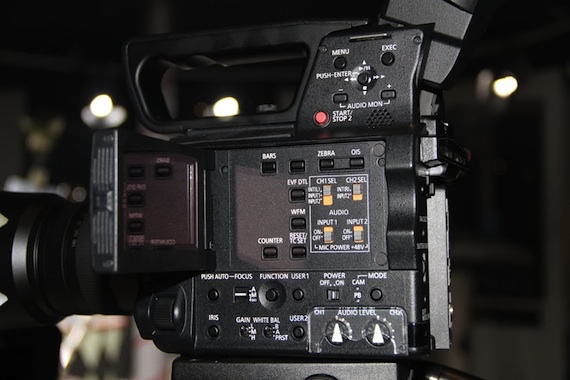
Panasonic have unveiled the AG-AF101 in Europe at the IBC.
This is the major first step-up image quality wise from the current video DSLRs we have seen since the original benchmark set by the 5D Mark II in 2008. For the first time we have a large sensor CMOS chip combined with the image processing hardware and functionality to back it up.
The sensor is much improved from the GH1 with lower noise and less banding. They have optimised it purely for video so rolling shutter is much improved. It has variable frame rates that crank all the way to 1080/60p, something current DSLRs can only dream of although the GH2 is rumoured to feature 60p in full HD mode as well.
In addition to 60p which is great for slow-motion, none of the moire or rolling shutter issues present on DSLRs plague the AF101. Far from it – this is a true 1080p video camera, in the mould of a interchangeable lens S35mm HPX170 – the implementation of it’s video codec is perfect and no detail is spared, unlike on a DSLR where most of it is skipped, binned or smudged out by poor compression.
However having become use to the small and light form factor of a DSLR for video, I am not sure I relish the prospect of a bulky video camera again – especially one that costs so much more than the average DSLR. After all, unless you are Barry Green and totally anal about ‘professional’ video functionality like zebras and dials for gain instead of ISOs, any camera remains a picture making box that you attach a lens to and point and a scene. The bells and whistles are always much less important than outright image quality and the class of talent operating the camera.
Professional studios will find monitoring much easier with the live video stream from the HD-SDI port on the AF101, whilst the camera is much less cramped to handle and has all the niceties that professional broadcast guys like on a body such as this. Audio is also much improved, with full manual control and XLR jacks.
But the AF100 does not have the full frame sensor of the 5D Mark II which remains unique. For some applications this is a serious disadvantage. One of the reasons the 5D Mark II got it’s job on House for instance, was it’s ability to render the actor’s faces without distortion with shallow depth of field in small spaces. With a 2x crop sensor, the field of view is different so you have to move the camera further back which changes the depth compression of the shot.
This is one of the reasons we have medium format cameras for studio work and portraiture in stills photography, because the huge imaging system helps better render people’s faces and allows a shallower depth of field, whilst reigning in depth – for example, the background remains nicely blurred but appears closer to the subject. It’s a more intimate look, and I believe these are the aesthetics the House team loved so much.
Don’t get me wrong – the AF101 is a fantastic camera. Build quality and handling exemplary, LCD screen much improved compared to almost anything else – different class to the GH1’s for a start!
Just don’t throw away your DSLR for one just yet.
For the vast majority of people, the camera’s bells and whistles are not worth the extra money over a 7D, 550D or 5D Mark II. Meanwhile the GH1 is about to be replaced with a camera featuring a newer evolution of the Panasonic NMOS sensor found in the AF101 – though whether it is as well optimised for video I very much doubt.
EOSHD.com will have a hands-on with the AF101 and GH2 at Photokina on the 21st September.
AF101 lens tip
One of the types of shot the AF101 excels in over a DSLR is the wide angle shot. Architecture, vistas, landscapes – it handles these so well, without softening the kind of fine detail crucial to such scenes. Often a DSLR will soften detail which lessens the impact of a vista, or even worse it may add moire to the scene over fine details and patterns – especially in architectural shots, bricks walls and roof tiles.
I’ve just invested in an Olympus 4/3rds 9-18mm wide angle lens, which will really start to pick up in terms of demand now we have a camera like the AF101 around. It’s by far the cheapest ultra wide angle lens for this sensor size, and is ultra sharp. I think the reason it’s only £350 compared to the more expensive Canon, Panasonic or Tokina equivalent is because nobody buys Olympus DSLRs any more, because they’re so behind the curve spec wise. You’d have to be a real Olympus hardcore to choose an E-3 over a 5D Mark II for example. The E-5 is set to remain at 12MP and have 720p video! Hope it’s good in low light!
Why the 9-18mm instead of the many other ultra wide lenses out there? Well, the Panasonic 7-14mm is more than double the price! The Canon 10-22MM EFS will lack aperture control on the AF101 as do all EF and EFS lenses and the Tokina 11-16mm F2.8 for 4/3rds mount isn’t as wide although it is a bit faster than the F4 Olympus and Panasonic lenses and remains a great choice for £500.


